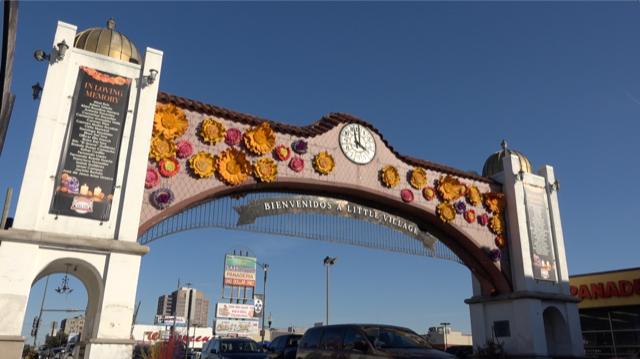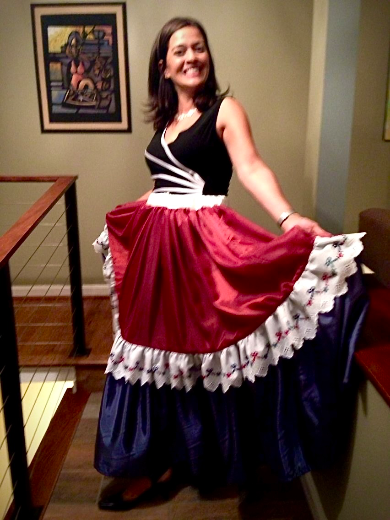After 31 years of the Little Village Arch serving as a symbol of the Mexican community in Chicago, the two-story terracotta structure is now an official city landmark — but Little Village residents express mixed emotions on the decision. The final vote on the landmark designation of the Little Village Arch came Wednesday after Chicago’s City Council gave the approval with zero objections.
Located in the community’s beloved 26th Street, the arch marks the beginning of the two mile strip filled with bakeries, taquerias and mom-and-pop shops.
For some Mexican Little Village residents like Ana Laura Saavedra, the landmark symbolizes resilience for her community.
“Our community has endured so many social and racial injustices, but yet our people continue to persevere,” Saavedra said. “When I see the Little Village Arch, I see the rich Mexican culture [and] also a sense of new beginnings.”
Growing up in Little Village, her earliest childhood memories revolved around the arch. At a young age, she remembers passing under the arch with her mother when going to doctor or dentist appointments.
“Being a daughter of immigrant parents and growing up in Little Village — it defines me,” Saavedra said.

Ana Laura Saavedra poses for a photograph in Little Village (Courtesy of Ana Laura Saavedra Facebook
Saavedra used the Little Village Arch as a sign of triumph when she graduated with her doctorate from Johns Hopkins University. With her cap and gown, Saavedra posed under the arch demonstrating to her community that she not only beat the odds, but takes pride in her roots.
“I couldn’t have done what I did without my upbringing,” Saavedra said.
Although she is proud that the arch is being recognized as a citywide landmark, she says the recognition is “long overdue.”
“[The arch] is the heart of Little Village. There’s no Little Village without that,” she added.
Other residents, like Ana Solano, 27, have different opinions on the decision taken by the Commission on Chicago Landmark department and City Council.
Solano, who is a Little Village resident of over 20 years and resides by the Crawford Coal Plant, says that although the landmark decision is historic, it overlooks the community’s bigger issues.
“I think it’s pretty cool that we get to mark our place in history but then again, it also feels very performative because it doesn’t really feel like it’s something substantial that people can improve their lives with,” Solano said.
An organizer in her spare time with Únete La Villita, a volunteer-based organization that focuses on advocating for affordable housing, Solano is more concerned with the City’s response to her community’s current struggles.
“Rent is going up,” she said. “A lot of our neighbors are getting displaced. With low wages and rent increases, it feels performative.”
“What’s the use of making it a landmark if the people that you’re displacing are not even going to get to enjoy it, it’s not going to be reflective of the community that’s here,” she added.
Solano hopes that city and community officials have the same initiative to work on improving and investing in the lives of Little Village residents.
The Little Village Arch was designed by Mexican architect Adrián Lozano and built by Balti Contracting Co. in 1990, according to a document by the City of Chicago. Costing about $275,000, the structure is set to resemble similar arched entrances found in the streets of Mexico.
The Little Village arch has an orange archway, two dome-capped stucco towers, sidewalk passages, a mechanical clock, a mosaic diamond pattern, an orange clay tile roof and a black metal sign reading “Bienvenidos A Little Village.”
Alderman Michael D. Rodriguez of the 22nd Ward, which covers part of Little Village, told La DePaulia via email that as a lifelong Little Village resident, he is excited by the historic designation.
“The landmark is a recognition of the importance of Little Village, and the Mexican American and immigrant communities to our region,” Rodriguez said. “Mexican Americans across the Midwest recognize the arch, that bears the message ‘Bienvenidos A Little Village’, as a symbol of their home.”
Often referred to as the “Mexico of the Midwest,” Mexican immigrants began arriving in Little Village and other neighborhoods in the late 1970s. According to data by the U.S Census Bureau and WBEZ, Latinos in Chicago are the second largest group and make up 29.9 percent of the city’s population.
“Little Village is where hundreds of thousands of individuals of Mexican ancestry have lived, worked, worshipped or conducted business over at least the last seven decades,” Rodriguez said.
In a 2020 report, the two-mile stretch shopping district that makes up 26th Street was the second highest grossing retail strip in Chicago following Magnificent Mile, home to luxurious and high-end brands.
“The landmark recognition of the Little Village arch is also a recognition of the vitality and economic strength of Little Village and of the Mexican American community in the Midwest United States,” Rodriguez said. “I am happy that the arch has been awarded a status that honors its architectural beauty and cultural significance.”

María Marta Guzmán is the Editor-in-Chief of La DePaulia, the online Spanish language section of The DePaulia, the award-winning newspaper produced by students at DePaul University.
Guzmán is a Senior at DePaul University majoring in Journalism and double minoring in Spanish and Latino Media & Communication.
A bilingual journalist born in Managua, Nicaragua, Guzmán wants to use her journalism passion to serve as a voice for the Latino community by covering stories involving immigration and international issues in Latin America.
Publisher’s Notes: You can read Guzmán’s Spanish language version of the city landmark designation of the Little Village Arch by clicking on: Arco de La Villita se convierte en un nuevo monumento oficial, residentes expresan emociones encontradas.
Illinois Latino News (ILLN) and La DePaulia are partners in best serving the Hispanic-Latino community.




